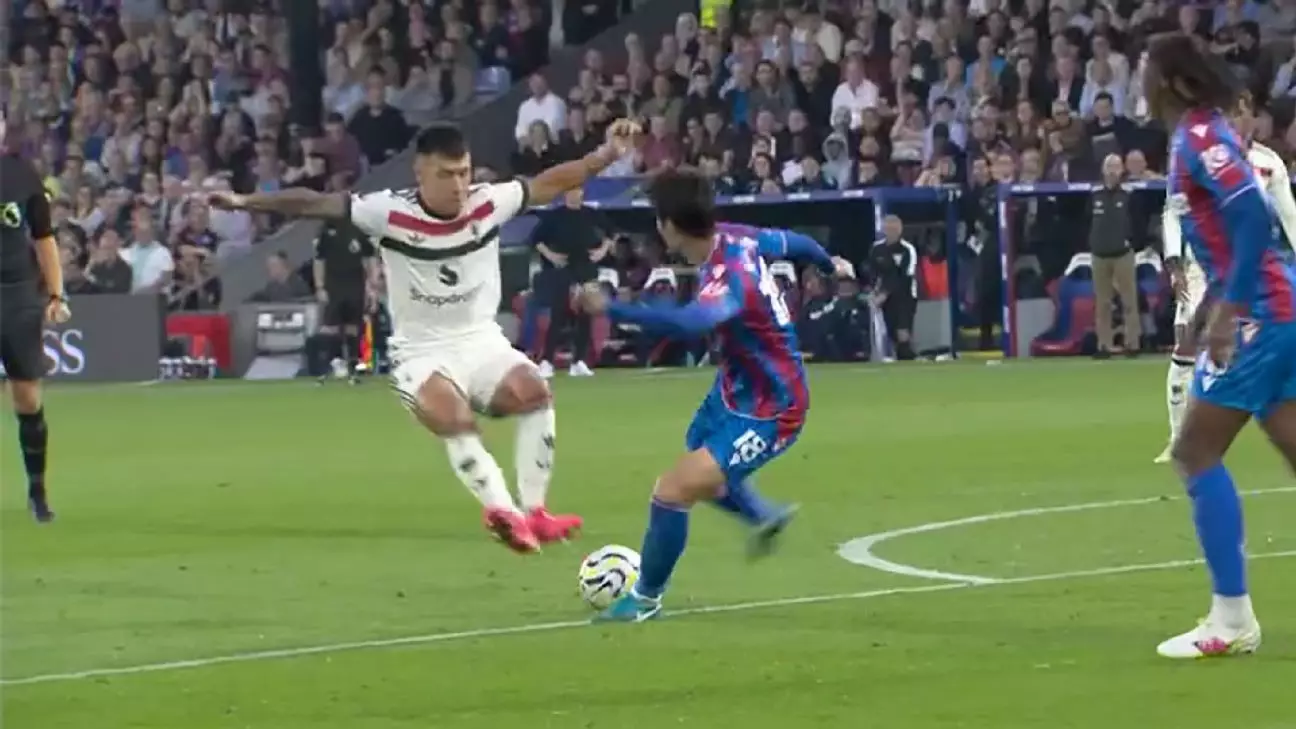The Video Assistant Referee (VAR) system was designed to bring clarity and fairness to football officiating, yet it often leads to contentious debates among fans, analysts, and players alike. Each weekend of Premier League action brings forth major incidents that warrant examination—not just belaboring whether a decision was right or wrong, but understanding the established protocols and the Laws of the Game that guide officials’ decisions. This article aims to illuminate recent VAR controversies, highlighting the inconsistencies and criticisms that have arisen, as well as the subjective nature inherent in officiating.
During a recent match between Manchester United and Crystal Palace, Lisandro Martínez’s tackle on Daichi Kamada became a flashpoint for debate. Martínez entered the challenge with two feet, a scenario that typically raises red flags in the realm of serious foul play. While referee David Coote opted for a yellow card after Martínez seemingly missed contact, VAR official Chris Kavanagh upheld that decision. The crux of the VAR review rested on the absence of direct contact with Kamada.
The failure to issue a red card reflects an alarming inconsistency with established interpretations of the laws regarding dangerous tackles. Football law is unambiguous in stating that intent to injure can warrant a red card even in cases where contact isn’t made. Martínez’s apprehensive approach to the ball suggested a disregard for the safety of his opponent. The VAR’s rationale for interpretation raises questions over whether officials are applying the law consistently.
In another incident involving Manchester United, a crumb of confusion circulated when a free kick into the area ricocheted off two Crystal Palace players’ arms. The absence of a penalty decision is noteworthy; the trend in recent officiating appears to be leaning toward laying a higher threshold for handball infractions.
VAR decisions have historically walked a nebulous line with these situations due to the subjective nature of player arm positioning. Both players had their hands naturally placed during the motion, not making any deliberate attempt to engage with the ball, which likely contributed to the decision not to intervene. However, the consistency of these judgments remains an area of scrutiny—previous seasons saw contentious handball calls, raising the prospect of whether a standard can be established.
The ongoing narrative around VAR came to the fore again following a goal scored by Arsenal’s Gabriel Magalhães in a tense match against Manchester City. The question arose: did Gabriel Martinelli foul City goalkeeper Ederson? The deciding VAR concluded that normal contact in a crowded six-yard box is acceptable as long as the attacking player does not consciously obstruct the goalkeeper’s movement. Such a ruling typifies the Premier League’s approach to allowing physicality in the box, but echoes of inconsistency reverberate when contrasting this decision with others throughout various matches.
The decision could lead to implications outside of England’s top-tier football, especially as other European leagues may opt to govern such matters more stringently. The crux of the matter lies in defining what constitutes fair play and physicality—differential interpretations consistently leave fans questioning refereeing decisions.
A notable instance of VAR scrutiny surrounded Erling Haaland’s behavior during a recent Manchester City match. After scoring an equalizer very late, Haaland tossed the ball at Gabriel—a move deemed petulant but ultimately did not meet the threshold for a red card according to VAR. It indicates a philosophical dilemma at the heart of officiating: should minor acts of disrespect warrant disciplinary action, or is it sustainable to reserve red cards for more egregious behavior? This balance is delicate, yet vital for an acceptable standard of conduct in the game.
As this season progresses, it’s critical to highlight the overarching concern regarding the subjectivity embedded within VAR decisions. The case involving West Ham’s Crysencio Summerville illustrates the difficulty in establishing a clear standard for what denotes a penalty. The referee deemed the contact insufficient, reflecting a broader trend where VAR seems loath to overturn on-field decisions unless they meet a relatively high threshold of error.
The continuous adjustments and shifting interpretations of rules suggest that while VAR was designed to alleviate critical decision-making errors, it inadvertently propels a cycle of inconsistency—a dilemma that undermines its initial purpose. The focus must evolve from narrowly assessing individual incidents to addressing the systemic flaws that give rise to various interpretations.
While VAR attempts to present an objective lens to subjective decisions, its current implementation continues to unveil disparity in how rules are enforced. For the Premier League, navigating this landscape will require ongoing reassessment of protocols, stronger communication of crucial decisions, and perhaps most importantly, the willingness to unify interpretations across matches. The road to clarity remains fraught, but continued dialogue and a commitment to improvement offer a glimmer of hope for fans and players alike.
